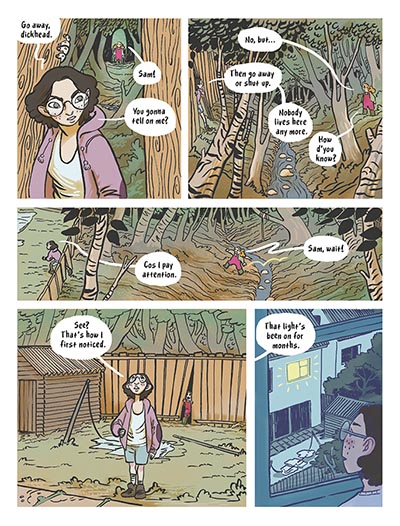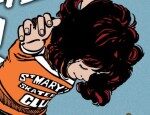Over the last several years Rebellion and the Treasury of British Comics have recognised the great fondness in which the short-lived late ’70s/early ’80s supernaturally themed girls comics Misty is held in with numerous reprint collections and new material in dedicated specials. With another Misty Special hitting shelves this week, this time with stories from acclaimed US comics writer Gail Simone, we chatted with two of the UK artists involved in the comic. Aly Fell and Letty Wilson are also two acclaimed faces on the current British small press scene. Today they talk to us about discovering Misty for the first time, their visual approach to their stories, and indie horror comics in the UK…

Cover by Tula Lotay
ANDY OLIVER: The original Misty, while relatively short-lived, is inarguably one of the great cult classics in British comics publishing history. When and how did you discover Misty and its eerie line-up of stories and characters?
ALY FELL: Hello and thanks for asking Andy. I discovered Misty a few years ago through my partner. She owned a number of the annuals and a few of the comics. I acquired a couple more including the Rebellion reissues/specials and thoroughly enjoyed them.
LETTY WILSON: I think I might have come across Misty through my parents’ old annuals at some point – I remember poring over the beautiful art in girls’ comics when I visited my grandparents, but I think Misty wasn’t among my favourites, or maybe just hadn’t been my mum’s favourites, as I don’t remember stories in particular from those. Later when I studied comics for the MLitt at Dundee I got a more thorough grounding in British comics history, including some great excerpts of Misty, and the amazing eye for detail and unusual page designs of many of the artists stuck with me.
Art by Aly Fell
AO: With the Treasury of British Comics having reprinted so much Misty material in recent years are there any stories from the comic’s acclaimed past that particularly stand out for you?
WILSON: As I say, I hadn’t had a particularly in-depth look at Misty beforehand, but when Ollie Hicks contacted me about this project they gave me a bunch of fantastic comics to read for reference and it was so fun diving into them. I loved so many of the “Beasts” type stories, such as those by Jordi Badia Romero with all their murky fairytale settings and ravenous, but often also fairly affable werewolves and vampires. Jaume Rumeu‘s work is also fascinating, his use of black and white is still an education, and a favourite is ‘Dressed to Kill’, a short story set at a fancy dress party with everyone dressed as different animals. it’s extremely camp and I love it.
FELL: ‘Mask of Fear’ creeped me out, and of course ‘The Four Faces of Eve’, but my collection needs to expand beyond the current physical copies and PDFs I have. I didn’t grow up with Misty – my childhood was Tintin, Asterix, Thor, Look and Learn, Action, Whoopee! and countless others. I even sent an entry into Whoopee! for ‘World Wide Weirdies’ that was redrawn by the great Ken Reid.
I still have the letter explaining I’d won a £2 postal order!
Art by Aly Fell
AO: Aly, you’ve had a long career bridging a number of different mediums but from a comics viewpoint I imagine it’s your self-published work, A Trick of the Light and The Kissing Gate, that Broken Frontier readers will probably be most familiar with. What can we expect from the third instalment in that supernatural quadrilogy?
FELL: Thank you. I’m beginning to drop little bits and pieces of the third book, which is finished in rough form, but still a long way from completion. It’s a [kind of] faery story, but also a mystery set in the 1920s. The faery influence is apparent in the title: To the Waters and the Wild, which is from a poem by W. B. Yeats, whose work I love. The book will be partially about obsession and loss, and continues thematically, some of the elements from A Trick of the Light and The Kissing Gate although remains unconnected.
It also takes direct inspiration from the Morcove stories featured in Schoolgirls Own from 1921 to 1936, at least in setting and period. Leonard Shields, who drew many of the covers and interior art for that comic/story-paper is largely forgotten these days, but was a superb draftsman.

AO: Given the retro/period feel of your visuals that we’ve come to know and love how much fun was it to evoke a 1970s feel in your story? Can you give us some insights into the collaborative process between yourself and Gail?
FELL: I have a photograph of me as a small thing with a Thunderbird 2 toy on my lap, which I suppose reveals that I don’t need a lot to remind me of the decade. In depicting a period such as the Seventies, I try not to look at present-day realisations of the era which are effectively once-removed from the past. I look at family photo albums, films made at the time and magazines that don’t show the glamour, but instead ordinary life. It’s easy to be clichéd about the past.
As for the process, Rebellion sent me the script, and opened up an email group where we could chat. Gail was brilliant. Any nuances that elaborated or changed her script in small ways, she was more than happy to adjust to. She specified ‘British’ in the feel for the story, alongside Hammer films and romance comics. So we made sure these descriptors weren’t lost in the transferral from script to art. But really, it didn’t need a lot of to-ing and fro-ing, as it is THAT smooth a process working with the folks at Rebellion and Gail.
AO: Letty, as a definite emerging star on the UK indie scene could you tell us a little about your comics projects prior to your Misty involvement?
WILSON: First of all, thank you, that’s very cool to hear! My recent comics work has mostly been focused on my webcomic, Owl People, which is an urban fantasy/folklore story about criminal fairies living in the underbelly of a Scottish city and getting into adventures. I’ve collected the first book of that for print, and the story is continuing online at the moment.
I also did a short comic with Quindrie Press as part of their launch collection, called The Beechwood Helm. It’s a queer Arthurian story that essentially gave me an excuse to draw armour and forests and ugly fights – some of my favourite things to draw! I had so much fun I’m currently planning how to do more like it.
AO: Your story is the only one in this special that is being handled by a sole creator. Are there any hints you can give us about its plot, themes or tone?
WILSON: The story is inspired by how spooky I think mirrors are, and that fear that you might see something in a mirror that just isn’t quite right – and maybe by the time you notice it, it’s already too late to do anything about it… Playing with mirrors also let me do some fun things with the art, and be a bit experimental, so that hopefully the comic has an interesting and spooky atmosphere! I wanted to draw the feeling you get when you are in an empty room but the occupants have only just left, moments before you arrived.
Art by Letty Wilson
AO: We seem to be particularly good in the British indie/small press scene at producing some exceptional horror comics work. Is there anyone whose work in that regard you have really enjoyed recently that you’d like to give a shout-out to?
WILSON: So many – as you say, horror comics in the UK indie scene are doing some amazing things! Erika Price’s work is a standout – her use of these bristling, anxiety-inducing heavy textures to tell stories that seem to be crawling off the page is great, every time she makes something new it seems she’s grown more powerful, always so excited to see what she’ll do next.
Llewellyn Rose is also maybe my favourite horror comic creator at the moment. Her story Jack for the Shortbox Comic Fair last year remains a perfect example of what comics can do to be really scary. Everyone should read it. I’m deranged about this particular comic.
FELL: YES! The other creators on this Misty special. Namely Gail Simone of course, Carola Borelli, Marianna Ignazzi, Ellie Wright, Tula Lotay and Letty Wilson. I think that’s everyone. Plus the team behind it at Rebellion.
I’m not slavishly ‘horror’ in my personal obsessions, as much as I enjoy it. So right now I currently have Tara Togs from Streff on the go (which wears its Tintin influence happily on its sleeve), Helen of Wyndhorn from Dark Horse, Gothic for Girls by Julia Round and I’m rereading my John Wyndham collection too, plus a bit of Daphne du Maurier. Also, I picked up a ton of stuff from the London Film and Comic Con, from David Leach, Ellie Wright (from Misty), Lew Stringer, Gary Erskine et al.
And, finally, If the opportunity were to arise would you be up for revisiting the worlds of Misty? Are there any horror subgenres you would like to tackle in this short story format?
FELL: Very much so. I enjoyed this enormously, as you can probably tell. I feel privileged to be the only male artist to be involved, as far as I know. As for sub-genres: maybe something hauntological, borderline folk-horror and… unsettling. That said, a bit of 1970s vampiric fun would be good too!
WILSON: Oh definitely! I feel like I barely scratched the surface with my story – as I guess is inevitable with a lot of shortform comics. I’d love to do more to tackle the very limited body types we’ve seen in the “classic” girls comics such as Misty. I want to make horror comics with fat characters, characters that aren’t necessarily pretty, and aren’t condemned by the plot for that. Also I’ve also yet to try my hand at a vampire story and I feel like that would be extremely fun.
Buy the Misty Special online here
Interview by Andy Oliver



















